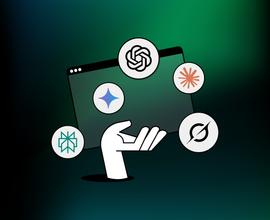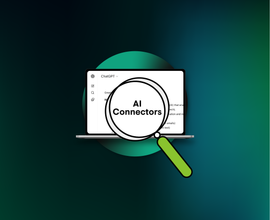Holiday AI SEO Tips for Black Friday & Cyber Monday in 2025
AI-powered shopping is growing 520% this holiday season, and platforms like ChatGPT now enable direct checkout. Get the tactics you need to show up in AI search results, track your brand's AI visibility, and drive holiday traffic from both traditional search engines and AI answer engines.
The holidays are quickly approaching, and holiday SEO strategies are already in full swing. But here’s what's new: the most significant variable in your holiday success isn't your budget or your team size—it's how well you use AI.
Adobe is predicting U.S. holiday shopping to cross $250 billion online , rising 5.3% year-over-year. Cyber Week alone is expected to drive $43.7 billion in online spend, with Black Friday growth set to outpace Cyber Monday for the first time in years.
But here's the biggest shift: online shopping behaviors are being reshaped by generative AI. Adobe predicts AI-assisted online shopping will grow 520% during the U.S. holiday season.
Consumers are embracing AI-powered chat services and browsers to research products and find deals. With AI Overviews dominating search results and platforms like ChatGPT now enabling direct checkout, the path to purchase looks completely different than it did last holiday season.
For eCommerce brands, this means your products need to show up not just in traditional search results, but also in AI-generated recommendations and shopping experiences.
That's why marketers need a strong holiday AI SEO strategy now and going forward. SEOs who embrace AI will have a competitive advantage this season. The challenge is that AEO / GEO and AI search are new enough that there isn’t a tried-and-true playbook just yet. AEO / GEO data can unlock powerful SEO insights, but what data can you draw conclusions from, and what's just noise?
What AI means for holiday SEO
Before diving into tactics, let's address what's actually changing. AI in SEO refers to how large language models (LLMs) and AI-powered search engines like ChatGPT, Google's AI Mode, and Perplexity are reshaping how people discover and evaluate products. Instead of clicking through ten blue links, shoppers are getting direct answers and recommendations from AI chat interfaces.
The question on everyone’s minds is whether traditional SEO is being replaced by AI. The answer is a definitive no—but it is evolving. Traditional SEO still drives the majority of online traffic and conversions. What's different is that you now need to optimize for both traditional search engines and AI answer engines. The good news is that many fundamentals overlap—quality content, clear site structure, and authoritative backlinksBacklinks
Backlinks are links from outside domains that point to pages on your domain; essentially linking back from their domain to yours.
Learn more matter for both.
Another question many SEOs are facing is whether AI-generated content is good for SEO and AEO. The answer depends on how you use it.
AI can accelerate your content creation process and help you identify optimization opportunities, but generic AI outputs won't rank well or convert. The key is using AI platforms that integrate your brand data, market insights, and SEO best practices to create unique, valuable content that serves both search engines and shoppers.
Now that we’ve covered the basics, here are the holiday AI SEO strategies we recommend for a successful Black Friday and Cyber Week:
1. Collect as much AI data as possible
This is the first year we'll have enough AI shopping data to draw real conclusions. Shopify and OpenAI just partnered to bring eCommerce capabilities to ChatGPT . That's a game-changer.
Real-world data about how your customers find and interact with your brand using AI will be invaluable for optimizing search strategies. Broad AI trends are interesting, but your data and your customers are what actually matter. Start tracking your AI search performance now.
Pay attention to how AI engines cite your product pages, landing pages, and holiday content. Which formats are driving visibility and click-through rates? That information is gold for understanding where you're winning—and where competitors are beating you.
For Conductor customers
AI Search Performance in Conductor collects your brand’s mentions and citations across all of the major AI search engines, including ChatGPT and Google’s AI Mode. It also measures your market share versus competitors and the sentiment of AI answers involving your brand. All of those data points will be vital in building your AI SEO strategy.
2. Optimize holiday content for AI search now
Data collection is critical, but you don't have to wait to start optimizing. Make AI-driven improvements to your site right now.
If you're already tracking AI search performance, use that data to guide your optimizations. Look for prompts where your brand gets mentioned but not cited. That gap usually means you're relevant but missing the content AI needs to reference. Fill that gap.
Even without hard data, you can optimize for how people use AI to search. One tactic we've seen work is publishing content about your specific Black Friday and Cyber Monday deals. This helps you get cited when someone asks AI, "What are the best Cyber Monday [your product category] deals for 2025?"
Create holiday-specific landing pages that answer high-intent queries directly. Include structured dataStructured Data
Structured data is the term used to describe schema markup on websites. With the help of this code, search engines can understand the content of URLs more easily, resulting in enhanced results in the search engine results page known as rich results. Typical examples of this are ratings, events and much more. The Conductor glossary below contains everything you need to know about structured data.
Learn more so both traditional search engines and LLMs can understand your offers, pricing, and availability. Use content formats AI loves—lists, FAQs, and clear summaries at the top of pages. These formats have always worked well, and AI engines can easily digest and serve them.
For Conductor customers
AI Search Performance and the Pages Report give you everything you need to make smart, data-backed decisions about your holiday AI search strategy. And if you need content to fill a gap, Writing Assistant is designed specifically to create optimized website content.
3. Maximize holiday visibility with strategic keyword/topic research
KeywordKeyword
A keyword is what users write into a search engine when they want to find something specific.
Learn more research isn't dead—it's more important than ever. Focus on long-tail keywords and topics that capture specific shopping intent. For example, "best Black Friday tech deals under $100" will drive higher conversionConversion
Conversions are processes in online marketing that lead to a defined conclusion.
Learn more rates than generic "laptop deals" searches.
Build gift guides for different segments. Create blog posts around what people are actually searching for: "gifts for him under $50" or "last-minute holiday gifts with free shipping." These holiday gift guides serve double duty—they rank in traditional search and give AI something citation-worthy.
Your keyword research should also identify question-based queries. People ask AI conversational questions like, "What should I buy my tech-savvy dad for the holidays?" instead of typing robot-speak into Google. Structure your holiday content to answer those natural questions directly.
For Conductor customers
Use Keyword Details to dig into the performance of your holiday keywords and topics. You'll see search volumeSearch Volume
Search volume refers to the number of search queries for a specific keyword in search engines such as Google.
Learn more trends, ranking positions, and AI Overview visibility—so you know exactly which topics are driving traffic in both traditional search and AI-generated results.
4. Build holiday-specific landing pages that convert
Your product pages need holiday optimization. Add seasonal copy, holiday imagery, and time-sensitive offers. Create dedicated landing pages for your biggest Black Friday and Cyber Monday promotions.
Page speed matters even more during high-traffic shopping periods. Most holiday shopping happens on mobile, so optimize for that experience first. Slow pages kill both your search visibility and your conversion rates—no one waits around for a sluggish checkout.
Use clear calls to action and urgency messaging. "Cyber Monday deal ends tonight" or "Limited holiday stock available" messaging creates the push shoppers need. Make sure your structured data includes offer details so AI can give shoppers accurate information about your deals.
5. AI SEO is in real time
Check your log files. We're seeing ChatGPT and other LLM bots crawling sites way more frequently than Google's bot. That's a massive shift.
Remember when publishing holiday content the week of Thanksgiving meant you were too late? Those days are over. AI answers update constantly because LLMs are always looking for fresh information. Keep updating your content throughout the season.
This real-time nature creates opportunities you didn't have before. Publish new Black Friday deals in the morning and watch them appear in AI shopping recommendations within hours. Stay agile—test approaches, measure results, iterate fast.
For Conductor customers
Log file analysis data in Conductor Monitoring shows you exactly when AI answer engine bots last crawled each page. You'll know when to expect results from your optimizations and get a clear picture of how AI bots interact with your site.
Learn how to set up and measure AI search readiness—discoverability, crawlability, and the likelihood of being cited—in Conductor Monitoring with our helpful how-to guide.
6. Check your technical foundations
Your website's technical health matters more than ever when AI bots are crawling your site several times a day. The foundations need to be solid for your holiday AI SEO strategy to work.
The most important thing to check right now is whether AI engines' bots can actually access your content. Some websites blocked AI bots earlier this year, and web hosting providers started blocking some of them because of cost and security concerns. Make sure the AI engines can see and serve your content to searchers.
All of the traditional SEO technical best practices still apply here. Fast load times, clean site architecture, proper redirects, and mobile optimization—these fundamentals benefit both traditional SEO and AEO / GEO. Don't skip the basics while chasing the new shiny object.
For Conductor customers
Conductor Monitoring is built for the age of real-time search. It's always on, tracking all of the most important technical health factors on your site. Use AI Crawler Activity to see exactly when and how AI bots are accessing your pages, so you can verify they're getting the content they need. You'll get alerts as soon as an issue is detected so you can fix problems before they impact traffic or revenue.
7. Leverage local SEO for holiday shoppers
Local search still matters for your holiday SEO strategy. Plenty of shoppers still search "Black Friday deals near me" or "stores open on Cyber Monday" when planning their trips. Update your business listings with accurate holiday hours, in-store promotions, and inventory info.
Even for eCommerce brands, local SEO has value. Highlight shipping speeds, local fulfillment centers, and regional promotions. AI engines often prioritize local results for shopping queries, especially for categories like food, gifts, and last-minute purchases.
8. Traditional SEO still matters
AEO / GEO is the future, but traditional SEO drives results today. Your holiday SEO strategy needs both.
- Get your on-page optimization basics right. Title tags, meta descriptions, headers—use your target keywords naturally. Write descriptive alt text for all product images. It helps with image search visibility and accessibility.
- Build quality backlinks to your holiday content. Connect with industry publications, get featured in gift roundups, and create shareable resources like trend reports. These links signal authority and boost your overall domain visibility.
- Monitor for technical issues that could tank your performance during the busiest shopping days of the year. Broken links, 404 errors, slow pages—they all hurt rankings and frustrate customers. Set up monitoring to catch problems fast.
- Start early with your content calendar. Top holiday content often gets published in September or October, giving it time to build authority before peak season. Plan your blog posts, gift guides, and promotions well ahead.
- Test everything on mobile first. Most shopping happens on phones, so your mobile experience needs to be flawless. Check your checkout flow, navigation, and load times on actual devices.
Remember: Watch what your competitors are doing. See what keywords they target, what content formats they use, and how they position offers. Use those insights to differentiate and capture market share.
For Conductor customers
Conductor's enterprise platform combines traditional SEO intelligence with AEO and AI-powered insights. From keyword tracking to competitor analysis to real-time monitoring, you get the complete picture of your holiday search performance. We have all of the data you need for a successful holistic search marketing program.
9. Personalize your holiday AI SEO approach
Generic holiday content won't win anymore. Use personalization to make your content relevant to specific customer segments. Create separate gift guides for different demographics, budgets, and interests. Tailor recommendations based on browsing patterns and purchase history.
AI engines are getting better at understanding context and providing personalized recommendations. Make their job easier by clearly defining who each piece of content serves. Label gift guides with specific descriptors like "Gifts for tech enthusiasts" or "Luxury holiday gifts under $500."
Segment your holiday campaigns based on customer data. Returning customers need different messaging than first-time visitors. High-value customers deserve exclusive early access to your best deals. This personalization improves conversion rates and your visibility in AI-powered shopping assistants that learn from behavior.







